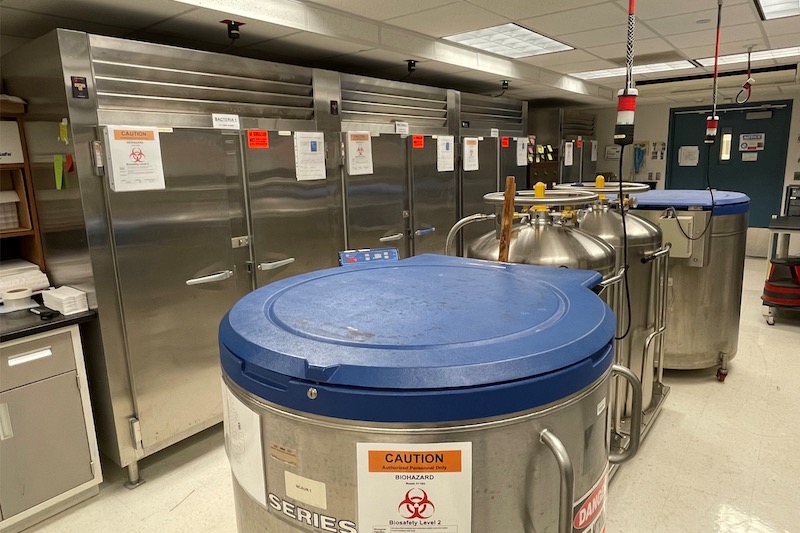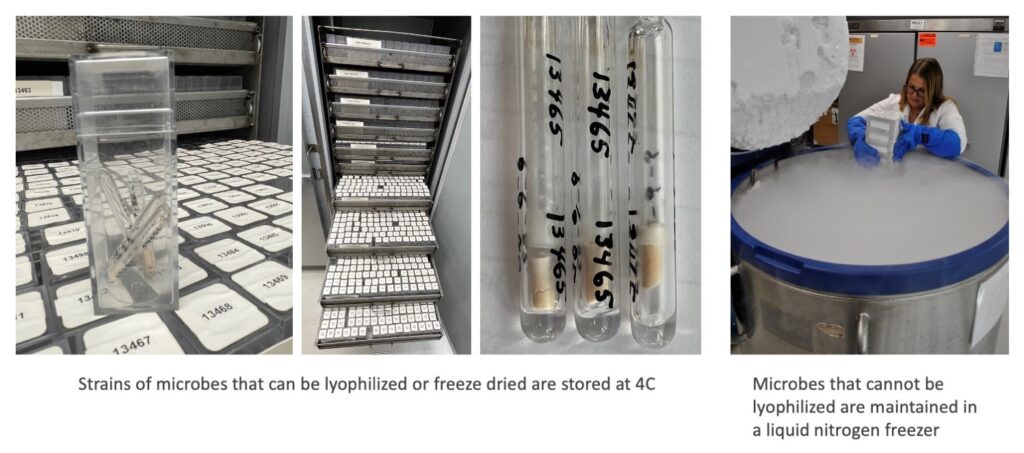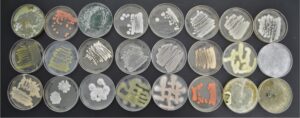
13 Sep Perspective of a federal culture collection curator on the proposed Specimen Management Plan
We chatted with Kirk Broders, curator of the USDA-ARS Culture Collection (NRRL), about the impacts the proposed Specimen Management Plan could have on federally funded culture collections.
NRRL and the proposed Specimen Management Plan
The USDA-ARS Culture Collection is a federally funded living collection staffed by two biological science technicians, a computer assistant that handles many of the administrative tasks, and the curator. This team is responsible for maintaining a collection of ~95,000 strains of bacteria and fungi and their associated metadata in a publicly accessible online catalog (https://nrrl.ncaur.usda.gov/).
The collection also distributes over 5,000 strains per year to researchers around the world, and accessions ~200-300 new strains of bacteria and fungi, which consists of preparing 12 lyophilized vial preps of each strain (if they can be lyophilized or freeze dried) and stored at 4C. For those microbes that cannot be lyophilized, they are maintained in a liquid nitrogen freezer.
 Overall, the collection managers I have spoken with, including those at both federal, academic and non-profit collection, are largely supportive of the proposed Specimen Management Plan (SMP) as this is an idea the collections community have been championing for some time. The preservation of biological material used in federally funded facilities is of equal importance to the data generated from this material, which is at the heart of the SMP concept. However, at the core of the SMP is the ability for biological collections to accession new specimens into their collections. In the case of living collections, this could represent a significant demand of time and resources to accommodate researchers who would be required to deposit material in a collection.
Overall, the collection managers I have spoken with, including those at both federal, academic and non-profit collection, are largely supportive of the proposed Specimen Management Plan (SMP) as this is an idea the collections community have been championing for some time. The preservation of biological material used in federally funded facilities is of equal importance to the data generated from this material, which is at the heart of the SMP concept. However, at the core of the SMP is the ability for biological collections to accession new specimens into their collections. In the case of living collections, this could represent a significant demand of time and resources to accommodate researchers who would be required to deposit material in a collection.
What will the demand be for repository space and can the NRRL help meet this demand?
It is almost impossible to estimate the amount of repository space that will be needed to house newly generated strains in NSF-funded research. The NRRL does have some limitations in meeting the demand. At present, the ARS Culture Collection is not authorized to charge users for strain requests or accessions. Furthermore, it is uncertain how much income user fees would generate, relative to the recurrent base funding appropriated by Congress. The Collection’s capacity is therefore primarily determined by those appropriations rate. The Collection currently limits the number of strains an individual lab can request to 24, and accessions are assessed on a case-by-case basis to accommodate as many requests as possible. In a typical year the Collection can accession a maximum of 500 isolates due to space and personnel limitations. We generally try to focus on accepting type specimens for new species descriptions and taxonomic groups that are currently not represented or underrepresented in the collection.
The other major limiting factor for the ARS Culture Collection’s capacity is physical space to store microbial strains. At the current accessioning rate, the ARS Culture Collection will run out of physical space (4C refrigerator and LN2 freezer space) in five to seven years. However, this timetable could be greatly accelerated if there is a significant demand from researchers who must deposit microbial strains as part of their SMPs. Unlike other public, non-profit, or private culture collection, as mentioned earlier, the Collection is not authorized to charge for its services. At present, the only way for the Collection to accommodate the potential increase in demand from the scientific community will be through increased appropriations that would enable hiring additional staff and expanding our physical footprint.
Does the U.S. have the infrastructure to accommodate the requirements in a proposed plan?
Assessing the adequacy of the U. S. infrastructure to conserve additional microbial cultures will require an up-to-date, extensive analysis of national microbial genebank capacity. The current capacity and demands on that capacity will likely vary significantly between taxa and between renewable or living collection (specimens can be propagated) and non-renewable collections (preserved specimens that cannot be propagated).
Will the current infrastructure be able to meet the demand?
At present, the ARS Culture Collection will likely not be able to accommodate the demand for increased accessions associated with the SMPs. As mentioned earlier, assessing the adequacy of the U. S. infrastructure to conserve additional microbial cultures will require an up-to-date, extensive analysis of national microbial genebank capacity. A 14-year old (2009) survey of federal biological collections found that many were barely able to modernize their collections with the support then available (1). From FY2000-2007, 78% of collections reported a predictable increase in holdings, but only 27% reported having support devoted to maintenance and management. In addition, 41% reported that their agencies had not specifically allocated funds for collection care and management, 40% reported declining numbers of collection support staff and only 5% reported increasing staff resources. This lack of a dedicated budget and staffing support suggests that actual support for collection management was not completely known then, hence the need for an updated analysis.
 The lack of support staff and funds for modernizing collections continues to hamper access to these collections by the research community. For instance, the same 2009 survey found that only 40% of collections had incorporated their specimen records into a computerized database and only 14% of collections operated a computerized database of their collection that was available to the public. This has likely improved over the last 14 years since the survey was conducted, but the gains could be modest as staffing shortages likely continue to be problematic.
The lack of support staff and funds for modernizing collections continues to hamper access to these collections by the research community. For instance, the same 2009 survey found that only 40% of collections had incorporated their specimen records into a computerized database and only 14% of collections operated a computerized database of their collection that was available to the public. This has likely improved over the last 14 years since the survey was conducted, but the gains could be modest as staffing shortages likely continue to be problematic.
Given the current demands on federal collections, it seems impossible for them to accommodate the potential increase in accessions associated with the SMP without any additional support for hiring of additional support staff and expanding digitization efforts.
Who determines which specimens are required/appropriate for storing?
These decisions should involve a discussion between the Principal Investigator (PI) of the project/grant and the collection curator. This conversation is critical and should occur as early as possible during the development of the grant. The PI should be aware of the availability or lack thereof of a specific collection for these purposes. The curator should be made aware of how many samples the PI would like to accession over the course of the project and determine if the collection is able to accommodate.
Will there be a certification requirement for repositories to store specimens?
A culture collection incorporated in an SMP should be able to ensure maintenance and availability of strains for a specified period of time, including accessioning and distributing these strains to the scientific public. Voluntary guidelines might be helpful for attaining those capacities. Potential voluntary guidelines must be discussed amongst collection curators, researchers that will deposit strains, and staff of microbial genebanks to ensure the needs of genebanks and customers/stakeholders are met.
Has NSF consulted other federal agencies? And what is the current discussion?
I believe there has been some discussion between agencies, but I am not aware of any details for these discussions.
What is the benefit to USCCN? Could one of the certification requirements be entering in USCCN registry?
The USCCN could serve in a couple of capacities. The USCCN website could list all extant microbial collections and the type of microbes they maintain. The USCCN could also function as a matchmaker to help PIs find the most appropriate collection for the type of specimens they hope to deposit. The USCCN could also serve an important role in outreach and education to raise awareness of the important role culture collections play in a variety of research fields and stress the importance of these collections and the additional workload created by new SMP requirements from NSF and potentially other funding agencies.
Disclaimer: The comments in this blog are those of the author and should not be construed to represent any official USDA or U.S. Government determination or policy.
Reference:
- National Science and Technology Council, Committee on Science, Interagency Working Group on Scientific Collections. Scientific Collections: Mission-Critical Infrastructure of Federal Science Agencies. Office of Science and Technology Policy, Washington, DC, 2009
